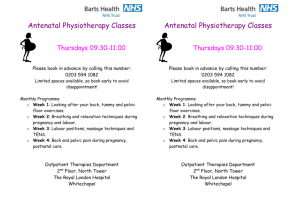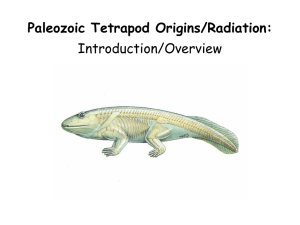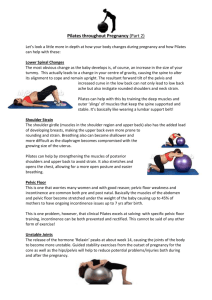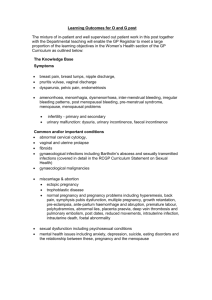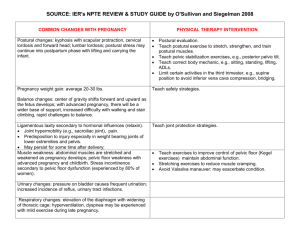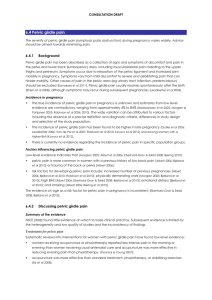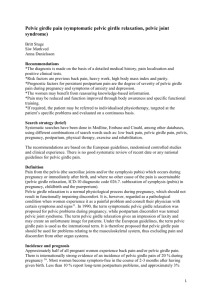MT on Pregnant Population
advertisement
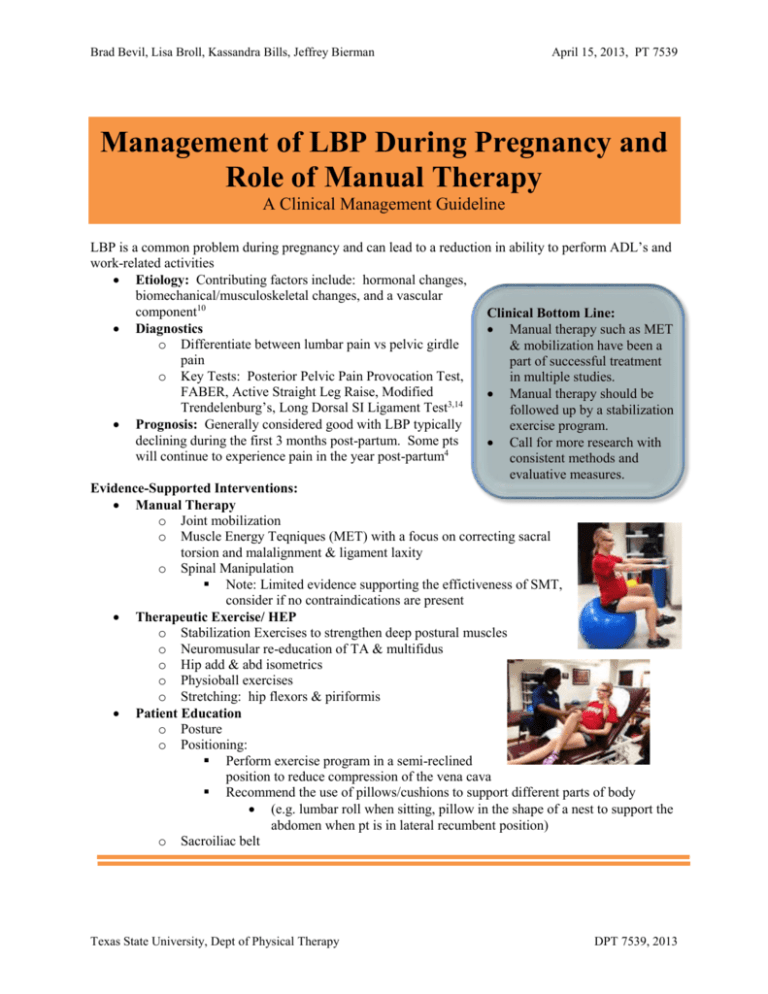
Brad Bevil, Lisa Broll, Kassandra Bills, Jeffrey Bierman April 15, 2013, PT 7539 Management of LBP During Pregnancy and Role of Manual Therapy A Clinical Management Guideline LBP is a common problem during pregnancy and can lead to a reduction in ability to perform ADL’s and work-related activities Etiology: Contributing factors include: hormonal changes, biomechanical/musculoskeletal changes, and a vascular component10 Clinical Bottom Line: Diagnostics Manual therapy such as MET o Differentiate between lumbar pain vs pelvic girdle & mobilization have been a pain part of successful treatment o Key Tests: Posterior Pelvic Pain Provocation Test, in multiple studies. FABER, Active Straight Leg Raise, Modified Manual therapy should be Trendelenburg’s, Long Dorsal SI Ligament Test3,14 followed up by a stabilization Prognosis: Generally considered good with LBP typically exercise program. declining during the first 3 months post-partum. Some pts Call for more research with will continue to experience pain in the year post-partum4 consistent methods and evaluative measures. Evidence-Supported Interventions: Manual Therapy o Joint mobilization o Muscle Energy Teqniques (MET) with a focus on correcting sacral torsion and malalignment & ligament laxity o Spinal Manipulation Note: Limited evidence supporting the effictiveness of SMT, consider if no contraindications are present Therapeutic Exercise/ HEP o Stabilization Exercises to strengthen deep postural muscles o Neuromusular re-education of TA & multifidus o Hip add & abd isometrics o Physioball exercises o Stretching: hip flexors & piriformis Patient Education o Posture o Positioning: Perform exercise program in a semi-reclined position to reduce compression of the vena cava Recommend the use of pillows/cushions to support different parts of body (e.g. lumbar roll when sitting, pillow in the shape of a nest to support the abdomen when pt is in lateral recumbent position) o Sacroiliac belt Texas State University, Dept of Physical Therapy DPT 7539, 2013 Brad Bevil, Lisa Broll, Kassandra Bills, Jeffrey Bierman April 15, 2013, PT 7539 References 1. 2. 3. 4. 5. 6. 7. 8. 9. 10. 11. 12. 13. 14. 15. 16. Fabio R. Efficacy of Manual Therapy. Phys Ther. 1992. 72: 853-864. Flynn T, Cleland J, Whitman J. Users’ Guide to the Musculoskeletal Examination. Buckner, KY: Evidence in Motion. 2008. Hall J, Cleland JA, Palmer JA, The effects of manual physical therapy and therapeutic exercise on peripartum posterior pelvic pain: two case reports. J Man Manip Ther. 2005; 13(2): 94-102 Katonis P, Kampouroglou A, Aggelopoulos A, Kakavelakis K, Lykoudis S, Makrigiannakis A, Alpantaki K. Pregnancy-related low back pain. Hippokratia. 2011; 15(3): 205-210. Khorsan R, Hawk C, Lisi AJ, Kizhakkeveettil A. Manipulative therapy for pregnancy and related conditions: a systematic review. Obstet Gynecol Surv. 2009;64(6): 416-27 Murphy DR, Hurwitz EL, McGovern EE. Outcome of pregnancy-related lumbopelvic pain treated according to a diagnosis-based decision rule: a prospective observational cohort study. J Manipulative Physio Ther. 2009; 32(8) 616-24. Nilsson-Wikmar L, Holm K, Oijerstedt R. Harms-Ringdahl K. Effect of three different physical therapy treatments on pain and activity in pregnant women with pelvic girdle pain: a randomized clinical trial with 3,6, and 12 months follow-up postpartum. Spine. 2005; 30(8): 850-856. Peterson CD, Haas M, Gregory WT. A pilot randomized controlled trial comparing the efficacy of exercise, spinal manipulation, and neuro emotional technique for the treatment of pregnancy-related low back pain. Chiropractic and Manual Therapies. 2012; 20(18). Requejo SM, Barnes R, Kulig K, Landel R, Gonzalez S. The Use of a modified classification system in the treatment of low back pain during pregnancy: a case report. J Orthop Sports Phys Ther. 2002; 32: 318-326. Sneag DB, Bendo JA. Pregnancy-related low back pain. Orthopedics. 2007; 30(10): 839-847. Stuge B, Hilde G, Vollestad N. Physical therapy for pregnancy-related low back and pelvic pain: a systematic review. Acta Obstet Gynecol Scand. 2003; 82: 983-990. Stuge B, Holm J, Vollestad N. To treat or not to treat postpartum pelvic girdle pain with stabilizing exercises? Man Ther. 2006; 11(4): 337-343. Stuge B, Laerum, Kirkesola G, Vollestad N. The efficacy of a treatment program focusing on specific stabilizing exercises for pelvic girdle pain after pregnancy: a randomized controlled trial. Spine 2004; 29(4): 351-359. Vermani E, Mittal R, Weeks A. Pelvic girdle pain and low back pain in pregnancy: a review. Pain Pract. 2010; 10(1): 60-71. Vollestad N, Torjesen P, Robinson H. Association Between the Serum Levels of Relaxin and Responses to the Active Straight Leg Raise Test in Pregnancy. Manual Therapy. 2012. 17(3): 225-230. Whitman J. Pregnancy, Low Back Pain, and Manual Physical Therapy Interventions. Journal of Orthopedic & Sports Physical Therapy. 2002. 32(7): 314-317. Texas State University, Dept of Physical Therapy DPT 7539, 2013
